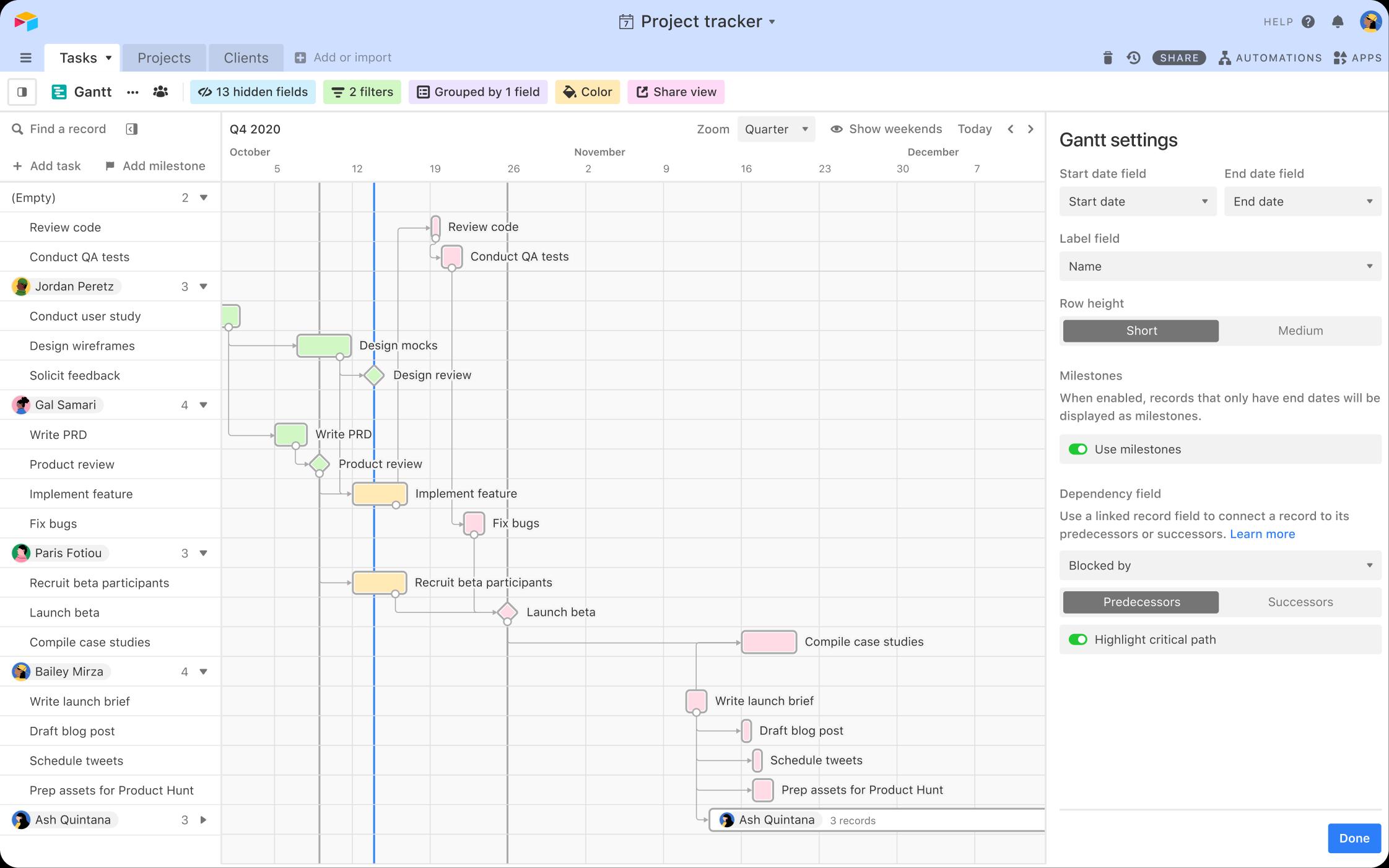Elevate project tracking with Airtable’s new Gantt view
A new, more visual way to track projects
A new, more visual way to track projects
Managing a large project is a bit like running a relay race. And everyone knows the most challenging part of a relay race is handing off the baton.
That’s where the Gantt chart comes in. A Gantt chart is a bit like a bar chart flipped on its side, where each bar signifies the timeline for part of a project. That makes it a highly collaborative way to view the timelines and dependencies on any given project.
The earliest Gantt charts were drawn on paper, which meant when the schedule changed, the entire thing had to be redrawn. To save time, clever project managers began to use physical objects—that they could physically adjust—to stand in for the chart bars. And when personal computers and the internet became ubiquitous, Gantt charts became digital and easily adjustable and accessible.
Today, we’re writing Gantt’s next chapter with its most customizable and adaptable version yet: Gantt View for Airtable.
Introducing Airtable’s Gantt view
We’ve taken all the best parts of our Gantt app and transformed it into an adaptable, intuitive view. Now available to Airtable Pro and Enterprise customers, the new Gantt view will help you visualize every aspect of your project, entirely in Airtable. Use it to better manage task dependencies, milestones, and more during every phase of your project’s lifecycle.
Here are a few ways you can use the Gantt view to make your projects run more smoothly, more efficiently, and with greater transparency:
Project management:
With a single source of truth for your project, you can plan action items, assign tasks, and update statuses all in one place. From simple to-do lists to complex, multi-project environments, Airtable’s Gantt view keeps everyone on the same page and moving in the right direction.
Production timelines:
Display start and finish dates for every project task and understand which tasks must be completed before others can begin. Whether you’re producing a marketing campaign, TV show, or a new line of designer dog bowls, the Gantt view can help you avoid costly delays and misunderstandings in your project timeline.
Resource management:
Plan, schedule, and allocate the resources you’ll need to complete your project efficiently. Track team capacity in real-time and assign tasks to a list of available team members. With visibility into available and required resources, you’ll know a pivot is necessary long before it’s critical.
What’s new with Gantt view
Rather than using a separate Gantt app, Gantt is now fully integrated into and available from within your Airtable base. With Gantt view, you get the utility of Gantt, paired with the flexibility of Airtable.
The view comes packed with the same functionality as the Gantt app, but with a host of new features, like the ability to:
Create and navigate to Gantt views directly from the view sidebar.
Make use of the full screen real estate without needing to access your Gantt from the apps dashboard or enter full screen mode.
Adjust filters and record coloring inline without needing to switch back and forth between the app and a source view.
Create standalone shares of Gantt views without exposing the rest of your base data.
In addition to enabling inline configuration, standalone sharing, and full-screen use, Gantt view also includes:
Milestones: Visualize specific milestones or deadlines in the project timeline.
Hide weekends: Make Gantt “workday-aware” and automatically account for weekends.
Nested grouping: Transition smoothly between high-level and granular views to meet the needs of multiple audiences, including employees, executives, and business partners.
Whether you’re new to Airtable’s Gantt’s functionality or already have experience with our Gantt app, Airtable’s Gantt view can help you optimize your project workflows and maximize efficiency. Here are three ways Airtable’s Gantt view can help you take your Gantt charts to the next level:
Facilitate stakeholder alignment and collaboration with view customization.
Project stakeholders need to see the correct information, in the proper context. Airtable’s Gantt view allows for filtering, grouping, and color coordination based on what information is relevant to each stakeholder.
Simplify what-if analyses and resource management with flexible data modeling.
Project timelines change, and your data model should be able to keep up. Gantt view—combined with the power of Airtable’s flexible relational data model—allows you to model and switch between different timelines.
Scale collaboration across teams and projects with Airtable’s extensible database.
Complex projects have constantly evolving dependencies and implications. Airtable’s database foundation can extend your Gantt view’s tasks and milestones to workflows on other teams, allowing everyone to stay in-sync.
How To Get Started With Gantt View
Now available to Airtable Pro and Enterprise customers, the Gantt views is accessible from the left sidebar.
To add the Gantt view, simply click on the "View" button near the top-left hand corner of your base, then select "Gantt" from the list of available view types. Then, configure your Gantt view.
Ready to give Airtable’s Gantt view a spin? Get started now.
Not on Airtable yet? Sign up for your free 2-week trial of Airtable Pro.
